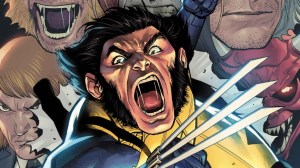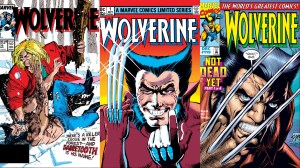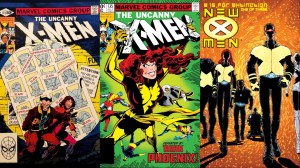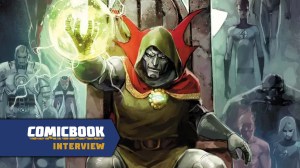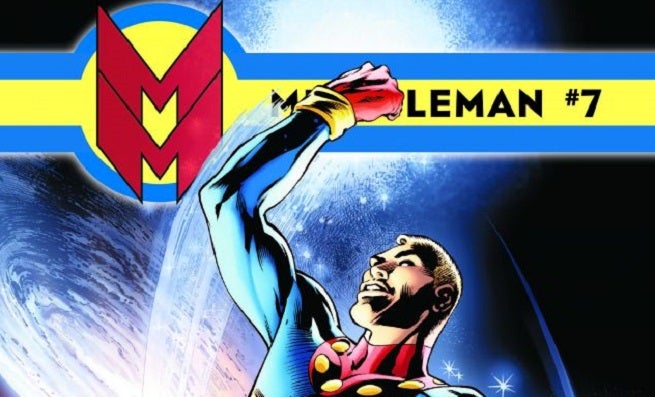
Videos by ComicBook.com
While Alan Moore’s writing remains as excellent as ever, the art is something that will have to be discussed in some detail. It’s a shame to see Davis go but the series remains just about as engaging as ever.
This is quite an eventful issue. We see the end of Dr. Emil Gargunza’s retelling of his backstory, his ultimate plan is revealed, Agent Evelyn Cream’s story comes to an end, we get a bit of a comics “in-joke,” and we end on a dark cliffhanger. In a change of pace, I’m going to go through chapter by chapter and discuss each as a whole before addressing the back matter. First though, the cover…
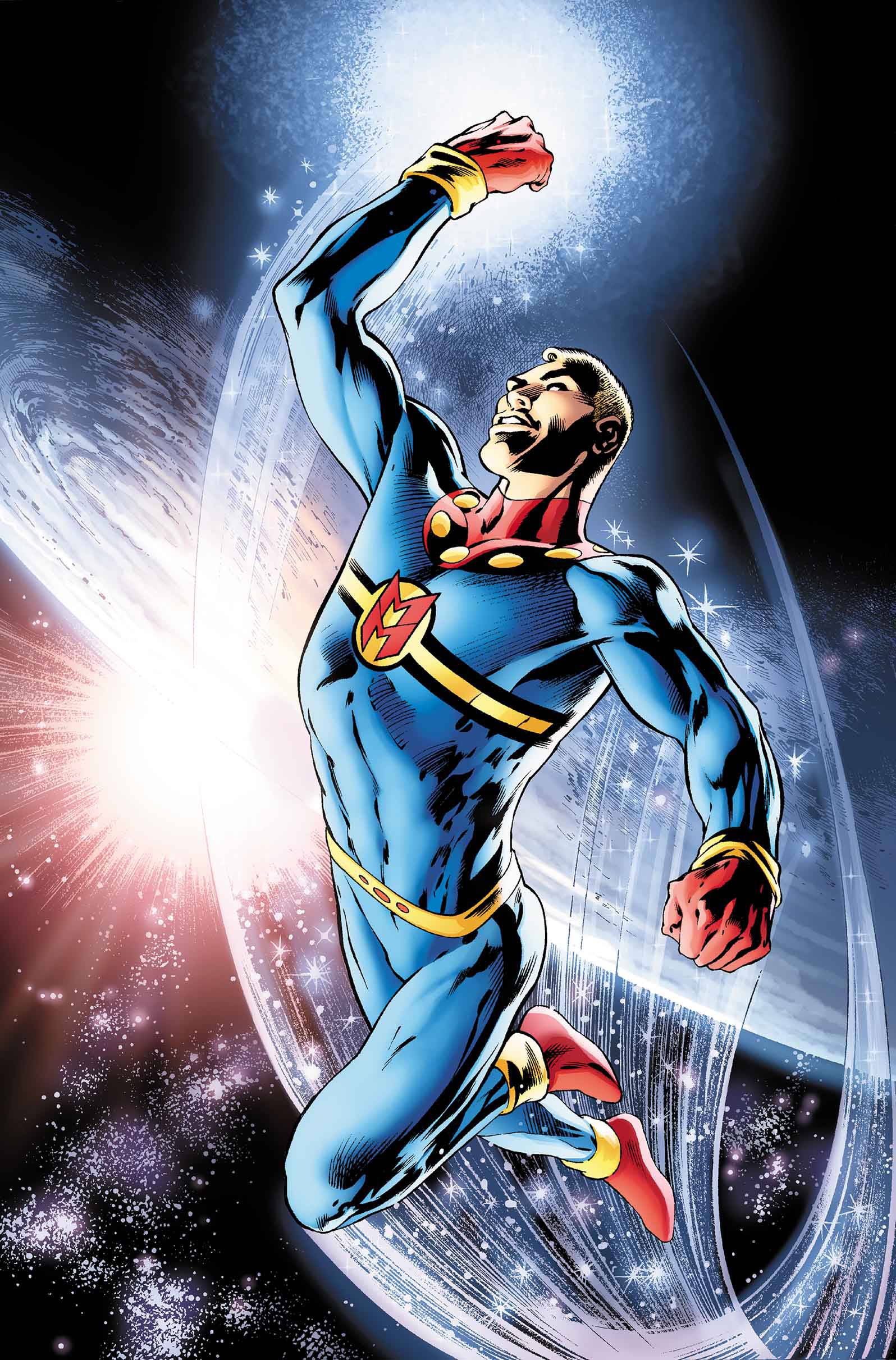
Perhaps it is churlish to complain about cover appropriateness in a series of reprints of a 30-year-old story but it’s something that takes away from this overall presentation for me. Oddly, there is a cover for this issue of Miracleman tearing through some metal which would at least reflect his initial attack on Gargunza’s compound; however, it is a variant and is still fairly generic all things considered. Still, beautiful artwork.
The first chapter in this book, “A Little Piece of Heaven,” features artwork by Alan Davis and it feels very much like a continuation of his previous chapters. As Gargunza describes his work in examining the alien spaceship and applying its technology to the creation of Miracleman, Davis artfully depicts a moth circling and then meeting its end by coming too close to a flame. The moth is depicted in a series of thinly horizontal panels, one at the top of each page, until the past page of this chapter when the dead moth is depicted on a complementary panel now at the bottom of the panel layout. It is both an interesting artistic move as well as an appropriate ending beat for the chapter immediately following the reveal of Gargunza’s plan. It is quite intriguing to consider who the moth is in this fairly apparent metaphor. The immediate choice is Gargunza and I expect that his presumably eventual demise will reflect that of this insect. I should also note that the panel layouts in general has a wonderfully regular structure that is repeated page after page. It is always nice to see artists make use of layouts like this. There is something about fitting a comic narrative into a fairly rigid structure and making it work to one’s advantage that puts me in mind of the poetic form of the sonnet.

I should also note that there is something delightfully naughty about seeing Captain Marvel and the Marvel Family depicted in this issue. They were Gargunza’s inspiration for Miracleman’s dream programming, which makes perfect sense given the history behind Miracleman’s creation by writer and artist Mick Anglo. Of course, this sense of mischief only comes about because it is Marvel reprinting this series and Captain Marvel (I’ll be darned if I call the character “Shazam”) is currently owned by DC Comics. Still, I got a kick out of it so I thought it worth mentioning.
The second chapter in this book, “…And Every Dog Has Its Day,” still features art by Alan Davis but it feels as though things are coming off the rails a bit. I to have to say that the first few pages of Miracleman and Cream smashing portions of the compound and locating Liz Moran, respectively, are beautifully and excitingly rendered. The problem is that once Gargunza and Miracleman start exchanging dialogue the quality takes a bit of a drop. The first few pages feel epic and tightly paneled, but the remainder seems jumbled and the art feels much less polished and lacking in detail. One could argue that this is deliberate and intended to mirror the transition from Miracleman to his schlubby, pajama-clad alter ego Mike Moran; however, that interpretation does not work for me.
If I had to guess, I would say that it was likely that Davis knew that he was at the end of his tenure and being unhappy about this for any number of reasons did not make quite the same effort he had previously. In particular, Mike Moran’s face when he calls for Cream looks much more amateurish that I’ve seen from Davis at any point in his entire run. There is certainly nothing to compare with the moth thread or repeated paneling of the previous chapter. Still, the art is serviceable and the depiction of “Miracledog” is reasonably impactful. I’m not sure why it needs a full page reveal but it’s not bad to look at. Oddly enough, I can’t help thinking of monsters from Japanese anime when I look at this thing. I’m not sure if this was intentional or if that would even be likely given the time period when this came out. Still, it’s an undeniable association, at least for me.
As far as Moore’s writing, there isn’t a ton to say here. Miracleman shows up and is stymied by another posthypnotic keyword by Gargunza. Gargunza then reveals the product of a process similar to that performed to create Miracleman but this time done to create a super-dog obedient to the mad scientist. It may be worth noting that the new posthypnotic keyword “Abraxas” has a host of meanings and significances, but it is all so complicated and jumbled that I can’t say what, if any, significance it has relative to this narrative. It’s also worth noting that Miracledog is (as I interpret it) a cute nod to Krypto the Superdog, both being “dog-staff” counterparts of a main hero from whom they take their name.
The final chapter for this issue, “All Heads Turn as the Hunt Goes By,” is where Chuck Austen takes over art duties. I have to say that I’m not pleased by the change as I was quite enjoying Davis’ work and he only appeared to be getting better with each successive chapter, at least until the last few pages of his final outing. It isn’t as though Austen is bad exactly but he doesn’t meet the standard set by Garry Leach and Davis. His art is perfectly serviceable and if I didn’t have anyone to compare him with on this series, might be perfectly satisfied. As it stands though, his art doesn’t feel as polished overall, faces are not as subtly expressive, figures feel much more stiff, and his panel layouts feel a bit thrown-together. I don’t actively dislike his work but I am disappointed. It’s as though I’m become accustomed to excellent filet mignon and was then handed a bog-standard hamburger.
The best compliment I can give the art is that I was pleased to see the little details of the large spider attacking the bird’s nest and the well-fed snake in the scenes where Cream and Moran are running away from Miracledog. They were nice touches, playing up the sense of predation in this scene. Unfortunately, I cannot say how much credit for this should go to Moore as opposed to Austen. Another nice bit is the rendering of the top-hatted skeleton-man who once again appears to Cream. He is surprisingly detailed and his pose is quite natural. In terms of any artistic flubs, there really isn’t anything that I can point to as a discrete mistake or particularly questionable choice. The issue is more just that the art overall is somewhat lackluster.
In terms of the writing, this chapter is pretty straightforward. The only part that deserves close analysis is Agent Evelyn Cream’s internal monologue. Once again he goes into a “jungle dream” and muses on his racial/ethnic heritage as a black man versus some vague concept of “whiteness.” Since Cream dies at the end of this chapter at the paws of Miracledog, this must be what his story and all his internal monologue was building toward but I’m still not sure I get it. Part of me wonders if the moth metaphor from the first chapter of this issue might not apply to him. Perhaps he is the moth, the dark is his ethnic/racial heritage, and the flame is some concept of power or status held by white people? Miracleman in this paradigm seems to represent the pinnacle of the power held by the white race/society. I feel uncomfortable even articulating this racially-charged material as I fear I may misinterpret it in some negative light. Honestly, I’m not sure what else to make of it though as Cream quite clearly articulates a “whiteness” that he “pursue[s] through the dark trees of our inner continent.” He also refers to Miracleman as a “pale god” and states that he “wanted the white miracle.” Again, the best interpretation that I can come up with here is of Cream as moth to flame, even if I cannot fully articulate the significance of the flame with absolute clarity.
Overall, I find Cream an intriguing aspect of the Miracleman story but one whose deeper meaning and internal life feels a bit superfluous in the final analysis. Looking back over his various internal interludes, I can see how some aspects of them foreshadowed his eventual death; however, I cannot say that whatever message or meditation Moore intended (if any) to convey regarding race came across successfully. Also, I’m a little miffed that I never got the backstory on his sapphire teeth and I guess I never will at this point.
Overall, the primary content of this issue is still quite excellent. Once again Cream is a confounding influence and the art does see a decline in quality, but the story is still very engaging and I’m honestly intrigued to see how Moran gets himself out of this mess. You see, Gargunza used the term “Abraxas” to turn Miracleman back into Moran. The word keeps him in his human state for an hour. He and Cream are then given a head start to run away from Miracledog before he is sicced on them. Cream hands Moran a gun before running off to be decapitated by Miracledog. The issue ends on a very human and very scared Moran confronted by the beast. I have no idea how he can save himself but I’m excited to find out.
Now for the back matter. While Marvel still hasn’t provided the kind of text pieces I’ve referenced in past reviews as being sorely missed, what they have provided is a bit more interesting than past efforts and given a bit more context. Now that Chuck Austen is on the book, we are provided with some of his pinup work. The captions are kind enough to explain that Austen had previously worked for Lucasfilm and at least some of these pinups were created in order to illustrate his ability and help to secure the position of artist on this series. A few images are even seeing print for the first time which is a nice treat. What follows the pinups are some of Austen’s pencil roughs for his work. I find these to be a bit more illustrative than the original art provided in past issues, particularly as one can, in some instances, see alterations made between the roughs and the final product. As such, these pencil roughs provide more insight into the artistic process.
Also provided is an original Marvelman adventure from Marvelman issue 159 (Sept. 1, 1956). While I keep making a point to lament the lack of text piece that would contextualize the debut of this material, I do quite enjoy the Marvelman reprints. This particular reprint is especially welcome as it ties very nicely into the content of the Miracleman narrative in this issue. In this story, Gargunza creates a machine that “steals” the word “Kimota” from Miracleman. Basically, it’s a box that records the word when Miracleman says it and in doing so prevents him from saying it again until the box is destroyed. This makes no sense but it is similar to Gargunza’s use of the term “Abraxas” to prevent Mike Moran from using “Kimota” to change into his alter ego. It’s an interesting parallel and make this an appropriate addition to the comic. It is at least a much better justification than the weak thematic linking of dreams in the last issue. I should also mention that artist Don Lawrence does great work here and particularly for the 1950s this is excellent stuff and surprisingly not dated. Lawrence’s work captures the characters’ anatomy perfectly and from a variety of engaging angles, faces are expressive, and when characters are in motion you can really feel it. I’m genuinely impressed.
In conclusion, while I’m less enthusiastic about this issue and was disappointed in a couple of areas, the story is still engaging and it has me excited for future installments. I still wholeheartedly recommend this series and encourage everyone to read it. I should point out that the first collected edition, Miracleman Book 1: A Dream of Flying, is now available and includes issues one through four. If you were trade-waiting, now is your chance to get in on the action.


